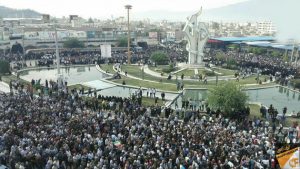
Archive photo- Mass demonstration in Kazerun in response to Iranian regime’s repressive measures -May 2018
Article published in the German version of HuffPost, assess that the situation in Iran is reaching a critical stage. However, it reminds that just like in 1977, when Iran was on the eve of political change, western governments have been slow to react. On December 31st, 1977, Jimmy Carter publicly described Iran as an “island of stability”. He could not have been more wrong. Just eight months later, Iran was rocked by anti-government protests daily, and the country soon went through a significant political change.
Iran is Ready for Change
The situation today looks eerily similar to Iran of 1978. The public, exasperated and frustrated with decades of oppression from the clerical regime and its corrupt practices and policies, are taking to the streets in unprecedented numbers.
Every public gathering and event has become an opportunity to vent their displeasure and frustration. For example, on May 27th, at a funeral for Iranian movie icon, Nasser Malek Motiei, those in attendance began chanting “death to the dictator, long live Nasser”. The protestors also lamented the state of Iranian television and radio, shouting “our state TV and radio is a shame”.
Others in the arts industries have taken to social media to express their discontent. After Rouhani, regime’s president invited Iranian artists to celebrate the fasting break in the month of Ramadan, many declined the invitation, publishing photos of their invites on social media and outlining reasons why they would be skipping the event. They cited reasons such as Rouhani turning a blind eye to those suffering across the country, leaving promises unfulfilled, and the imprisoning of artists and political prisoners, the article writes.
In other sectors, there is the same story. The nationwide truck driver’s strike has left fuel stations empty, with drivers on strike across 242 cities. Last month protests ravaged the city of Kazerun. Protestors clashed with agents of the state and the Revolutionary Guards shot and killed four demonstrators. This gave rise to yet more protests at the funerals of the martyred protestors.
#Iran ’s Truck Driver Protests Enter the Eleventh Day https://t.co/j9n96Epmgv#MEK#FreeIran2018#اعتصاب_کامیونداران
— MEK Iran (Mujahedin-e Khalq) (@MEK_Iran) June 2, 2018
The article sums up that in the final week of May there were no less than 489 individual protests across Iran, an average of 69 a day. Workers protests accounted for 33 of them, nine came from investor communities, four were carried out by the country’s retired population, 406 were from the haulage and trucking industries, three came from teachers, three from political prisoners, and 29 came from other sectors of society.
The protests have spread across all sectors of Iranian society, and each demographic has its own distinct cause. Some are protesting dire economic conditions, some drought, others the crippling unemployment rate, while others are expressing dissatisfaction at rampant corruption.
No End in Sight
The regime has resorted to the same oppressive tactics in each case. It makes arrests, tortures prisoners, executes many involved, threatens others against joining the protest movement, and disseminates fear and intimidation.
But these methods will not quell the protests. Each protest that is successfully carried out provides hope and generates momentum for the next protest. The more the people can see the regime losing its grip, the more people it inspires to take to the streets.
The HuffPost article determines that the protestors cannot be intimidated and repressed through violence. The crisis is too severe this time. The economic problems Iran is facing are too widespread.
A More Organised Protest Movement
The Iranian opposition is also far more organized than it has ever been before. The People’s Mujahedin Organisation of Iran (MEK) has worked tirelessly organizing protests and drawing international attention to the plight of the Iranian people.
Its efforts have received the interest of the clerical regime. Representatives of the state have blamed MEK for its role in the protest movement and expressed dismay at its ability to inspire the Iranian people to make their voices heard.
Europe’s Role
The article concludes that the US is beginning to understand the untenable position Rouhani and his regime occupy in Iran. It is reviving old sanctions and considering a tougher stance towards the regime. However, like Jimmy Carter in 1977, European heads of state are burying their heads in the sand and ignoring the situation in Iran.
Persevering with a policy of appeasement towards the regime lacks political sense. The Iranian citizens have made their opinion clear. They want regime change. The intensification of protests has shown that the status quo cannot continue. Regime change is on the horizon. Europe would be in a far better position when it does if it adjusts its position now and ends its financial and political investment in Rouhani and the mullahs. Betting on him now is a bet on a dead horse.
Staff Writer
